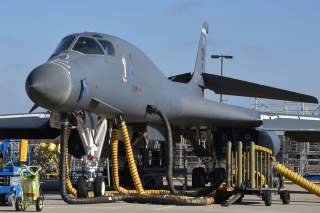Watch out China: B-1B Strategic Bombers Have Successfully Tested LRASM Anti-Ship Missiles
Powerful weapons.
“As LRASM moves toward early operational fielding for the U.S. Air Force and U.S. Navy, the weapon system continues to demonstrate critical capabilities that our warfighters need.”
A U.S. Air Force (USAF) B-1B from Dyess Air Force Base (AFB) has successfully test-fired a pair of production representative Long Range Anti-Ship Missiles (LRASMs).
The event took place over the Sea Range at Point Mugu, California. It was the second dual-LRASM test event, says LRASM program director, David Helsel, in a Lockheed Martin news release.
The missiles navigated through all planned waypoints, transitioned to mid-course guidance and flew toward the moving maritime target using inputs from the onboard sensors. The missiles then positively identified the intended targetand impacted successfully.
“As LRASM moves toward early operational fielding for the U.S. Air Force and U.S. Navy, the weapon system continues to demonstrate critical capabilities that our warfighters need.”
LRASM is designed to detect and destroy specific targets within groups of ships by employing advanced technologies that reduce dependence on intelligence, surveillance and reconnaissance platforms, network links and GPS navigation in contested environments. LRASM will play a significant role in ensuring military access to operate in open ocean/blue waters, owing to its enhanced ability to discriminate and conduct tactical engagements from extended ranges.
LRASM is a precision-guided, anti-ship standoff missile based on the successful Joint Air-to-Surface Standoff Missile – Extended Range (JASSM-ER). It is designed to meet the needs of U.S. Navy and U.S. Air Force warfighters in contested environments. The air-launched variant provides an early operational capability for the U.S. Navy’s offensive anti-surface warfare Increment I requirement to be integrated onboard the U.S. Air Force’s B-1B in 2018 and on the U.S. Navy’s F/A-18E/F Super Hornet in 2019.
This article by Dario Leone originally appeared on The Aviation Geek Club in 2018.
Image: DVIDS Hub.

